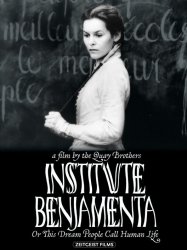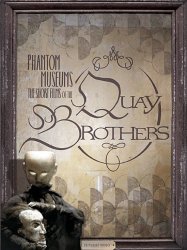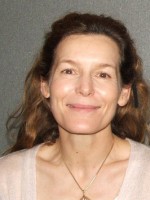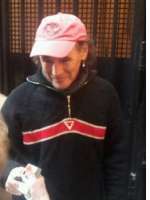Frères Quay is a Director and Scriptwriter American born on 17 june 1947 at Norristown (USA)

Stephen and Timothy Quay (/ˈkweɪ/ KWAY; born June 17, 1947) are American identical twin brothers better known as the Brothers Quay or Quay Brothers. They are influential stop-motion animators. They are also the recipients of the 1998 Drama Desk Award for Outstanding Set Design for their work on the play The Chairs.
Les Quay montrent un goût particulier pour les influences ésotériques. Ils commencent avec les animateurs Polonais Walerian Borowczyk et Jan Lenica et continuent ensuite avec les écrivains Franz Kafka, Bruno Schulz, Robert Walser et Michel de Ghelderode, Wladyslaw Starewicz et Richard Teschner et les compositeurs Leoš Janáček, Zdeněk Liška et Leszek Jankowski. Ce dernier a orchestré une grande partie de ses compositions pour les frères Quay.
Ils travaillent plus tard comme graphistes aux Pays-Bas, ils vont faire une rencontre déterminante : Keith Griffiths, un autre étudiant du Royal College of Art, qui travaille pour le British Film Institute et les poussera à mettre en scène en 1979 un film de marionnettes intitulé Nocturna Artificiala. Il produira tous leurs films. Une fois cette animation terminée, les frères Quay créèrent leur propre société de production avec le producteur Keith Griffiths, la Koninck, grâce à laquelle ils réaliseront quelques documentaires dont Le Cabinet de Jan Svankmajer (1984), commandité par Channel Four, ainsi que des courts métrages sur Igor Stravinsky : The Paris Years en 1983 ou encore l'Art de l'anamorphose (De Artificiali Perspectiva) en 1991. La Koninck résidera dans le sud de Londres dans la ville de Southwark.
La plupart de leurs films sont réalisés dans une ambiance sombre, lunatique. Leur travail le plus connu est Street of Crocodiles , basé sur une nouvelle de l’auteur polonais et artiste Bruno Schulz. Ce film a été sélectionné par le directeur et l’animateur Terry Gilliam comme l’un des 10 meilleurs films d’animations de tous les temps. Ils ont aussi dirigé une séquence d’animation dans le film Frida.
Malgré quelques exceptions, leurs films ne possèdent que de petits dialogues, beaucoup n’en possèdent pas comme The Comb (1990) qui inclut un fond de multi langage de charabia.
Leurs films dépendent beaucoup de leurs compositions musicales, dont la plupart furent écrites spécialement pour eux par le compositeur Polonais Leszek Jankowski. En 2000, ils vont contribuer à un court métrage de la série Sound On Film de la BBC dans lequel ils mettent en image une piece de 20 minute écrite par le compositeur Karlheinz Stockhausen. Dès qu’ils le peuvent, les frères Quay préfèrent travailler avec de la musique pré-enregistrée.
Ils ont aussi créé des musiques de vidéos pour His Name Is Alive (Are We Still Married, Can't Go Wrong Without You), Michael Penn (Long Way Down (Look What the Cat Drug In)) et 16 Horsepower (Black Soul Choir).
Beaucoup de personnes pensent que les Quay sont responsables de plusieurs clips. Ceux de Tool pour "Sober" et "Prison Sex" ont en fait été créées par Fred Stuhr et Adam Jones qui travaillent sous l’influence des frères Quay. Et bien que ces derniers aient travaillé sur la vidéo Sledgehammer (1986) de Peter Gabriel comme animateurs, ce projet a été dirigé par Stephen R. Johnson et ils n’ont pas été satisfaits de sa contribution pensant qu’il imitait trop le travail de Švankmajer.
Parallèlement à leur carrière de cinéastes, les frères Quay créent des décors pour le théâtre, des productions d’opéra dirigées par Richard Jones : The Love for Three Oranges de Prokofiev, A Flea in Her Ear de Feydeau, Mazeppa de Tchaikovsky, et la pièce de théâtre de Molière Le Bourgeois gentilhomme. Ils créent aussi des décors pour The Chairs de Ionesco qui a été nominées au Tony Award en 1998. Ils réalisent aussi des intermèdes pour des chaînes de télévision et aussi des spots publicitaires.
Mais c'est en 1995 que tous deux se lancent dans la réalisation de long métrage de fiction avec Institut Benjamenta ou This Dream People Call Human Life. Dix ans plus tard, L'Accordeur de tremblements de terre, sera une libre adaptation du roman L'Invention de Morel d'Adolfo Bioy Casares dans laquelle évolue Amira Casar. Entre-temps, les Quay ont continué à travailler pour le théâtre, à participer à des expositions organisées par le British Museum et la Tate Modern et à réaliser des courts métrages dont In Absentia en 2000 sur une partition spécialement écrite par Karlheinz Stockhausen.
Source : Wikidata
Frères Quay

Birth name (identical twins)
Nationality USA
Birth 17 june 1947 (77 years) at Norristown (USA)
Awards Guggenheim Fellowship
Nationality USA
Birth 17 june 1947 (77 years) at Norristown (USA)
Awards Guggenheim Fellowship
Biography
Les frères grandissent à Norristown en Pennsylvanie et s'inscrivent au Philadelphia College of Art, une école en illustration. C’est pendant cette période dans cette école qu’ils voient pour la première fois les films de Bunuel, Dreyer, Tarkovski et Bergman dans les cours consacrés au cinéma. Ils décident alors de réaliser eux-mêmes quelques courts métrages de fiction et deux films d'animation utilisant comme procédé des collages. Après l'obtention de leur diplôme en 1969, ils s'inscrivent au Royal College of Art de Londres et réalisent à cette époque trois petits films d'animation : Der Loop der Loop, Il Duetto et Palais en flammes.Les Quay montrent un goût particulier pour les influences ésotériques. Ils commencent avec les animateurs Polonais Walerian Borowczyk et Jan Lenica et continuent ensuite avec les écrivains Franz Kafka, Bruno Schulz, Robert Walser et Michel de Ghelderode, Wladyslaw Starewicz et Richard Teschner et les compositeurs Leoš Janáček, Zdeněk Liška et Leszek Jankowski. Ce dernier a orchestré une grande partie de ses compositions pour les frères Quay.
Ils travaillent plus tard comme graphistes aux Pays-Bas, ils vont faire une rencontre déterminante : Keith Griffiths, un autre étudiant du Royal College of Art, qui travaille pour le British Film Institute et les poussera à mettre en scène en 1979 un film de marionnettes intitulé Nocturna Artificiala. Il produira tous leurs films. Une fois cette animation terminée, les frères Quay créèrent leur propre société de production avec le producteur Keith Griffiths, la Koninck, grâce à laquelle ils réaliseront quelques documentaires dont Le Cabinet de Jan Svankmajer (1984), commandité par Channel Four, ainsi que des courts métrages sur Igor Stravinsky : The Paris Years en 1983 ou encore l'Art de l'anamorphose (De Artificiali Perspectiva) en 1991. La Koninck résidera dans le sud de Londres dans la ville de Southwark.
La plupart de leurs films sont réalisés dans une ambiance sombre, lunatique. Leur travail le plus connu est Street of Crocodiles , basé sur une nouvelle de l’auteur polonais et artiste Bruno Schulz. Ce film a été sélectionné par le directeur et l’animateur Terry Gilliam comme l’un des 10 meilleurs films d’animations de tous les temps. Ils ont aussi dirigé une séquence d’animation dans le film Frida.
Malgré quelques exceptions, leurs films ne possèdent que de petits dialogues, beaucoup n’en possèdent pas comme The Comb (1990) qui inclut un fond de multi langage de charabia.
Leurs films dépendent beaucoup de leurs compositions musicales, dont la plupart furent écrites spécialement pour eux par le compositeur Polonais Leszek Jankowski. En 2000, ils vont contribuer à un court métrage de la série Sound On Film de la BBC dans lequel ils mettent en image une piece de 20 minute écrite par le compositeur Karlheinz Stockhausen. Dès qu’ils le peuvent, les frères Quay préfèrent travailler avec de la musique pré-enregistrée.
Ils ont aussi créé des musiques de vidéos pour His Name Is Alive (Are We Still Married, Can't Go Wrong Without You), Michael Penn (Long Way Down (Look What the Cat Drug In)) et 16 Horsepower (Black Soul Choir).
Beaucoup de personnes pensent que les Quay sont responsables de plusieurs clips. Ceux de Tool pour "Sober" et "Prison Sex" ont en fait été créées par Fred Stuhr et Adam Jones qui travaillent sous l’influence des frères Quay. Et bien que ces derniers aient travaillé sur la vidéo Sledgehammer (1986) de Peter Gabriel comme animateurs, ce projet a été dirigé par Stephen R. Johnson et ils n’ont pas été satisfaits de sa contribution pensant qu’il imitait trop le travail de Švankmajer.
Parallèlement à leur carrière de cinéastes, les frères Quay créent des décors pour le théâtre, des productions d’opéra dirigées par Richard Jones : The Love for Three Oranges de Prokofiev, A Flea in Her Ear de Feydeau, Mazeppa de Tchaikovsky, et la pièce de théâtre de Molière Le Bourgeois gentilhomme. Ils créent aussi des décors pour The Chairs de Ionesco qui a été nominées au Tony Award en 1998. Ils réalisent aussi des intermèdes pour des chaînes de télévision et aussi des spots publicitaires.
Mais c'est en 1995 que tous deux se lancent dans la réalisation de long métrage de fiction avec Institut Benjamenta ou This Dream People Call Human Life. Dix ans plus tard, L'Accordeur de tremblements de terre, sera une libre adaptation du roman L'Invention de Morel d'Adolfo Bioy Casares dans laquelle évolue Amira Casar. Entre-temps, les Quay ont continué à travailler pour le théâtre, à participer à des expositions organisées par le British Museum et la Tate Modern et à réaliser des courts métrages dont In Absentia en 2000 sur une partition spécialement écrite par Karlheinz Stockhausen.
Usually with
Filmography of Frères Quay (6 films)
Director
 , 1h39
, 1h39Directed by Frères Quay
Origin German
Genres Drama, Science fiction, Fantasy, Musical, Romance
Themes La fin du monde, Disaster films, Films about earthquakes
Actors Amira Casar, Gottfried John, Assumpta Serna
Rating61%





A 19th-century opera singer is murdered on-stage shortly before her forthcoming wedding. Soon after being slain by the nefarious Dr. Emmanuel Droz during a live performance, Malvina van Stille is spirited away to the inventor's remote villa to be reanimated and forced to play the lead in a grim production staged to recreate her abduction. As the time for the performance draws near, piano tuner of earthquakes Felisberto sets out to activate the seven essential automata who dot the dreaded doctor's landscape and make sure all the essential elements are in place. Once again instilled with life after her brief stay in the afterworld, amnesiac Malvina is soon drawn to the mysterious Felisberto as a result of his uncanny resemblance to her one-time fiancé Adolfo.

In Absentia (2000)
, 20minutesDirected by Frères Quay
Origin United-kingdom
Genres Animation
Rating69%





A seated woman, alone in a chair at a table in a room on one of the top floors of an asylum, repeatedly writes on a piece of paper and sharpens pencils. The pencil point often breaks under her fingers' force. She places the broken points outside the window on the sill. A satanic figure is somewhere nearby, animated and made of straw or clay, not flesh. A spotlight lights up her window randomly. She finishes her writing, tears the paper from the pad, folds it, places it in an envelope, and slips it through a slot that contains many more letters. Great emphasis is placed on extreme close-ups of the objects central to her existence: the pencils, the sharpener, the paper, her cramped, clenching hands, blackened fingernails, endless stubs of broken-off lead, and finally the letters themselves, packaged up and 'posted' uselessly into a grandfather clock.

The Sandman (2000)
Directed by Frères Quay
Origin United-kingdom
Genres Drama
Themes Dance films
Actors Heathcote Williams, Alice Krige
Rating65%





 , 1h44
, 1h44Directed by Frères Quay
Origin United-kingdom
Genres Drama, Animation
Actors Alice Krige, Mark Rylance, Gottfried John
Rating70%





The plot follows Jakob, a young man who enters a school, run by brother and sister Herr and Lisa Benjamenta, which trains servants. The teachers emphasize to the students that they are unimportant people. Jakob finds the school to be an oppressive environment, and does not enjoy the lessons in subservience that he receives. He proceeds to challenge the Benjamentas and attempts to shift their perspectives. Lisa is attracted to Jakob and spends time with him, and shows him the secret labyrinth below the school. Lisa soon dies and after her death the institute closes. Herr Benjamenta and Jakob then leave together.

This Unnameable Little Broom (1985)
, 11minutesDirected by Frères Quay
Origin United-kingdom
Genres Fantasy, Horror, Animation
Rating69%





In the film, Gilgamesh is a grotesque, Picasso-esque being who moves by tricycle and patrols his box-shaped kingdom that hovers above a dark abyss. The yellow walls are inscribed with calligraphic text and its seemingly vast expanse is randomly broken up by square holes from which medical hooks occasionally project. A table – a mechanism and a trap – concealing a pulsating vagina within one of its drawers, stands at the centre of Gilgamesh’s domain. High above this space are strung high-tension wires, vibrating in the wind, one caught with a broken tennis racquet. First, Gilgamesh is seen setting up a bizarre trap to lure and catch the wild man Enkidu (who is depicted as a bird-like creature, partially made of genuine animal skeletons). Enkidu appears to live in a distant forest world visible through a hatch in the side of one of the walls of the floating kingdom. Gilgamesh is seen eating dandelion fluff during the opening credits before he finishes readying the trap. Once finished, Gilgamesh retreats to a room beneath the floor of the floating kingdom, awaiting Enkidu's arrival. Sometime later, Enkidu enters and becomes intrigued by a table with an anatomical, H.R. Giger/da Vinci-esque image of a woman's muscles (symbolizing the character Shamhat). The mechanism activates allowing Enkidu to look inside the image revealing a swaying piece of meat on a hook within the woman’s body. A drawer on the table opens, revealing the pulsating vagina. Ecstatic, Enkidu begins to mount the table, which sets off Gilgamesh's trap, flinging him onto the high-tension wires. An excited Gilgamesh resurfaces, retrieving the ensnared Enkidu by means of a giant gold cloth. Gilgamesh binds his captive with twine, beats him with a spiked club, and brushes his wings before cutting them off with scissors. Gilgamesh cuts the twine binding Enkidu and as the gold cloth falls to the ground the viewer is given a shot of Enkidu’s forest. The same fluff that Gilgamesh was eating earlier litters the forest floor and the viewer is allowed to observe an insect husk rapidly decay. In the end, Gilgamesh is seen riding frenzied circles around Enkidu, who is now trapped beneath the table-mechanism on which the trap was set.

Nocturna Artificialia (1979)
, 21minutesDirected by Frères Quay
Origin United-kingdom
Genres Animation
Rating63%





The story is told in eight parts and begins with a man in his apartment. He sees a red tram out his window and leaves his apartment to wait for the next tram to come by. As he sees the next tram approaching him, he puts his arms up to signal it to stop. At the same time, the wind begins to blow and a curtain from an open window in his apartment complex blows outward toward the sky. He boards the tram and for a while rides through the night continuously looking forward instead of out the windows at the scenery. Finally, in slow motion, he begins to move toward the curtain on the window of the tram and pulls it back. He sees strange objects as he passes through the night(such as a dart board and some tree trunks held up by metal bars). All these objects are the only thing he can see when he passes them because they are engulfed in light, while the areas surrounding the objects is pitch black. As the tram continues on, it appears to disappear around him and he is back in a makeshift version of his apartment looking out the blinds of his window. He closes the blinds and seems to be startled by something. He follows it to the vent in his wall and looks into it. There appears to be nothing in the vent and he turns away disappointed. The wind begins to blow harder outside as another tram passes by his apartment complex. He then gets the idea to take off the screen of his vent and stick his hand into it. As he reaches trying to find anything in the vent the scenery of the movie changes again and he is back riding on the tram holding what looks like a crumbled piece of paper with a blood stain on it. After he sees the paper he passes out in the seat of the tram and awakens in the makeshift version of his apartment. He puts the crumbled, blood-stained paper on a hanger to dry and the movie begins to spin showing different unidentifiable objects. Finally, the movie stops spinning and shows the front of a church. The man is again inside of the red tram, that seems to be driving through the middle of the church, looking out of the window. The screen switches from pitch black to different arts on the inside of the church in the point of view like the audience themselves are riding the tram. Time passes and the man is at a loss of where he is. He looks around confused and again, finds himself in his apartment. It is obvious that time has passed because the lighting is much darker and the mood is much more sleepy. After this, the man is on the tram and the scenery switches between him on the tram and the objects from earlier in the movie. The man is riding along and the tram accelerates. The tram goes faster and faster and the man's head thrusts back as the wind blows against him. This results in him falling off of a chair that he apparently played like it was the tram. He falls backward off the chair and hits his head on the ground. He tries to get up, but fails. More time passes (as can be seen as the light from outside rises and falls) and he is still motionless on the ground as the movie ends.
Scriptwriter
 , 1h44
, 1h44Directed by Frères Quay
Origin United-kingdom
Genres Drama, Animation
Actors Alice Krige, Mark Rylance, Gottfried John
Rating70%





The plot follows Jakob, a young man who enters a school, run by brother and sister Herr and Lisa Benjamenta, which trains servants. The teachers emphasize to the students that they are unimportant people. Jakob finds the school to be an oppressive environment, and does not enjoy the lessons in subservience that he receives. He proceeds to challenge the Benjamentas and attempts to shift their perspectives. Lisa is attracted to Jakob and spends time with him, and shows him the secret labyrinth below the school. Lisa soon dies and after her death the institute closes. Herr Benjamenta and Jakob then leave together.
 Connection
Connection




